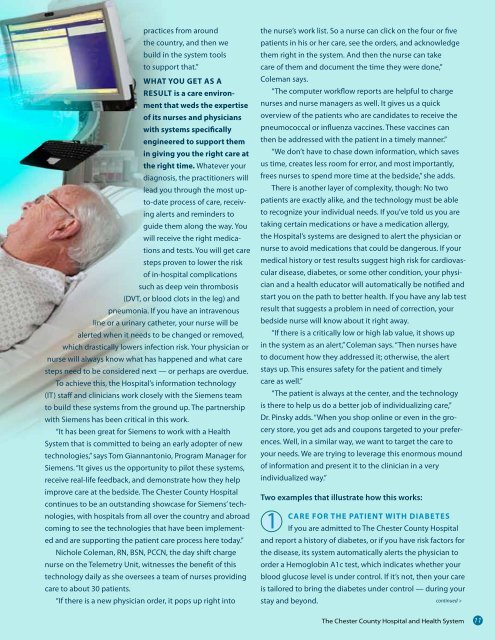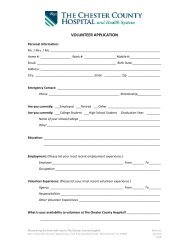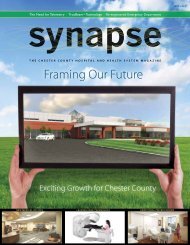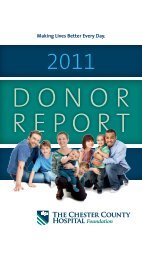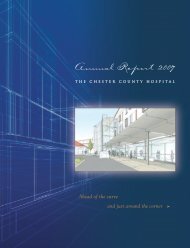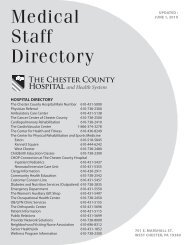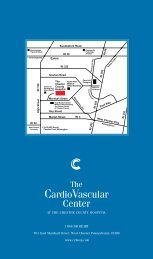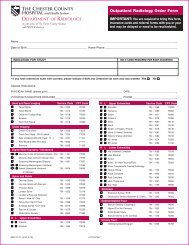synapse - The Chester County Hospital
synapse - The Chester County Hospital
synapse - The Chester County Hospital
- No tags were found...
You also want an ePaper? Increase the reach of your titles
YUMPU automatically turns print PDFs into web optimized ePapers that Google loves.
practices from aroundthe country, and then webuild in the system toolsto support that.”What you get as aresult is a care environmentthat weds the expertiseof its nurses and physicianswith systems specificallyengineered to support themin giving you the right care atthe right time. Whatever yourdiagnosis, the practitioners willlead you through the most upto-dateprocess of care, receivingalerts and reminders toguide them along the way. Youwill receive the right medicationsand tests. You will get caresteps proven to lower the riskof in-hospital complicationssuch as deep vein thrombosis(DVT, or blood clots in the leg) andpneumonia. If you have an intravenousline or a urinary catheter, your nurse will bealerted when it needs to be changed or removed,which drastically lowers infection risk. Your physician ornurse will always know what has happened and what caresteps need to be considered next — or perhaps are overdue.To achieve this, the <strong>Hospital</strong>’s information technology(IT) staff and clinicians work closely with the Siemens teamto build these systems from the ground up. <strong>The</strong> partnershipwith Siemens has been critical in this work.“It has been great for Siemens to work with a HealthSystem that is committed to being an early adopter of newtechnologies,” says Tom Giannantonio, Program Manager forSiemens. “It gives us the opportunity to pilot these systems,receive real-life feedback, and demonstrate how they helpimprove care at the bedside. <strong>The</strong> <strong>Chester</strong> <strong>County</strong> <strong>Hospital</strong>continues to be an outstanding showcase for Siemens’ technologies,with hospitals from all over the country and abroadcoming to see the technologies that have been implementedand are supporting the patient care process here today.”Nichole Coleman, RN, BSN, PCCN, the day shift chargenurse on the Telemetry Unit, witnesses the benefit of thistechnology daily as she oversees a team of nurses providingcare to about 30 patients.“If there is a new physician order, it pops up right intothe nurse’s work list. So a nurse can click on the four or fivepatients in his or her care, see the orders, and acknowledgethem right in the system. And then the nurse can takecare of them and document the time they were done,”Coleman says.“<strong>The</strong> computer workflow reports are helpful to chargenurses and nurse managers as well. It gives us a quickoverview of the patients who are candidates to receive thepneumococcal or influenza vaccines. <strong>The</strong>se vaccines canthen be addressed with the patient in a timely manner.”“We don’t have to chase down information, which savesus time, creates less room for error, and most importantly,frees nurses to spend more time at the bedside,” she adds.<strong>The</strong>re is another layer of complexity, though: No twopatients are exactly alike, and the technology must be ableto recognize your individual needs. If you’ve told us you aretaking certain medications or have a medication allergy,the <strong>Hospital</strong>’s systems are designed to alert the physician ornurse to avoid medications that could be dangerous. If yourmedical history or test results suggest high risk for cardiovasculardisease, diabetes, or some other condition, your physicianand a health educator will automatically be notified andstart you on the path to better health. If you have any lab testresult that suggests a problem in need of correction, yourbedside nurse will know about it right away.“If there is a critically low or high lab value, it shows upin the system as an alert,” Coleman says. “<strong>The</strong>n nurses haveto document how they addressed it; otherwise, the alertstays up. This ensures safety for the patient and timelycare as well.”“<strong>The</strong> patient is always at the center, and the technologyis there to help us do a better job of individualizing care,”Dr. Pinsky adds. “When you shop online or even in the grocerystore, you get ads and coupons targeted to your preferences.Well, in a similar way, we want to target the care toyour needs. We are trying to leverage this enormous moundof information and present it to the clinician in a veryindividualized way.”Two examples that illustrate how this works:1Care for the Patient with DiabetesIf you are admitted to <strong>The</strong> <strong>Chester</strong> <strong>County</strong> <strong>Hospital</strong>and report a history of diabetes, or if you have risk factors forthe disease, its system automatically alerts the physician toorder a Hemoglobin A1c test, which indicates whether yourblood glucose level is under control. If it’s not, then your careis tailored to bring the diabetes under control — during yourstay and beyond.continued ><strong>The</strong> <strong>Chester</strong> <strong>County</strong> <strong>Hospital</strong> and Health System 11


